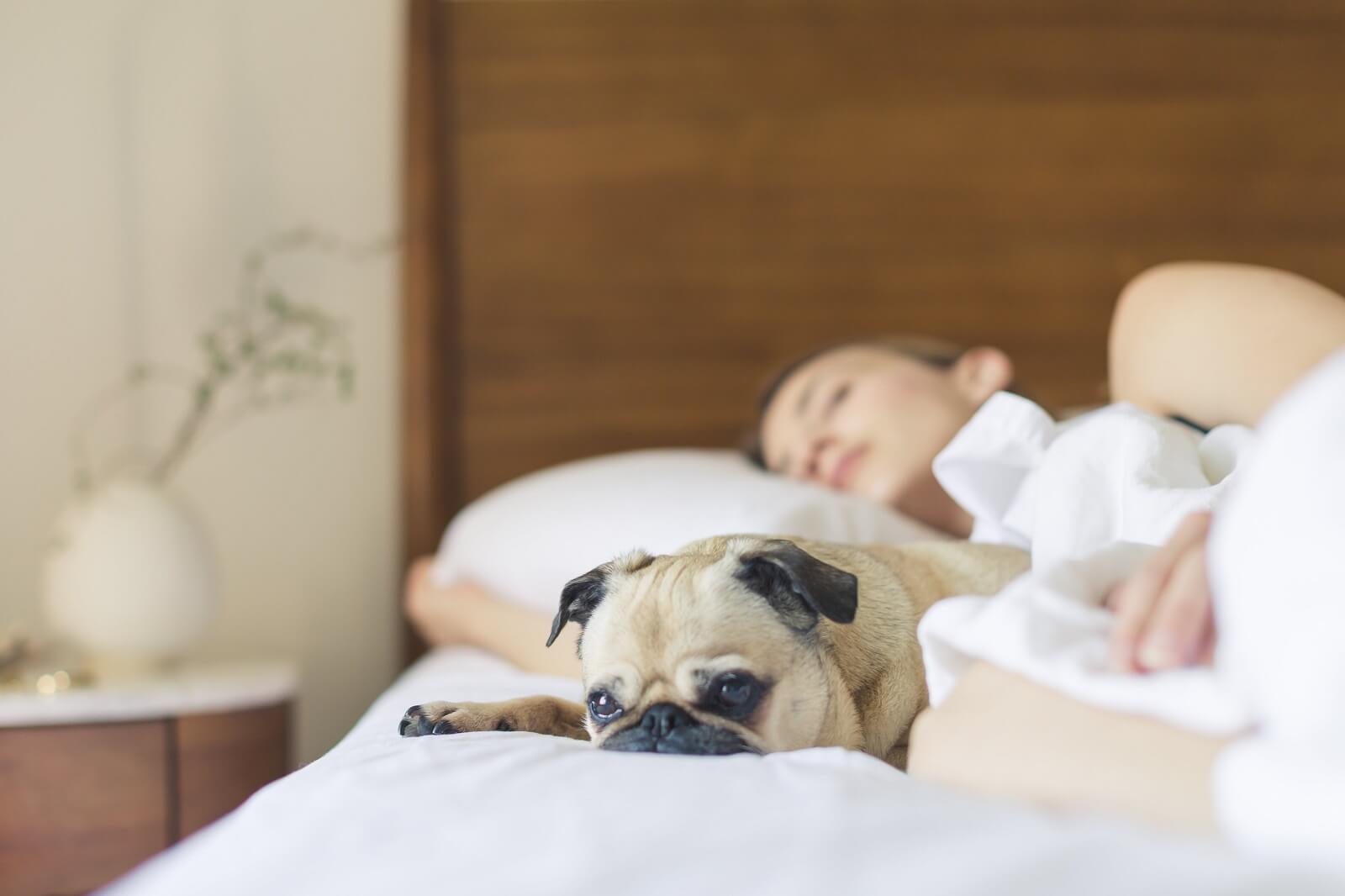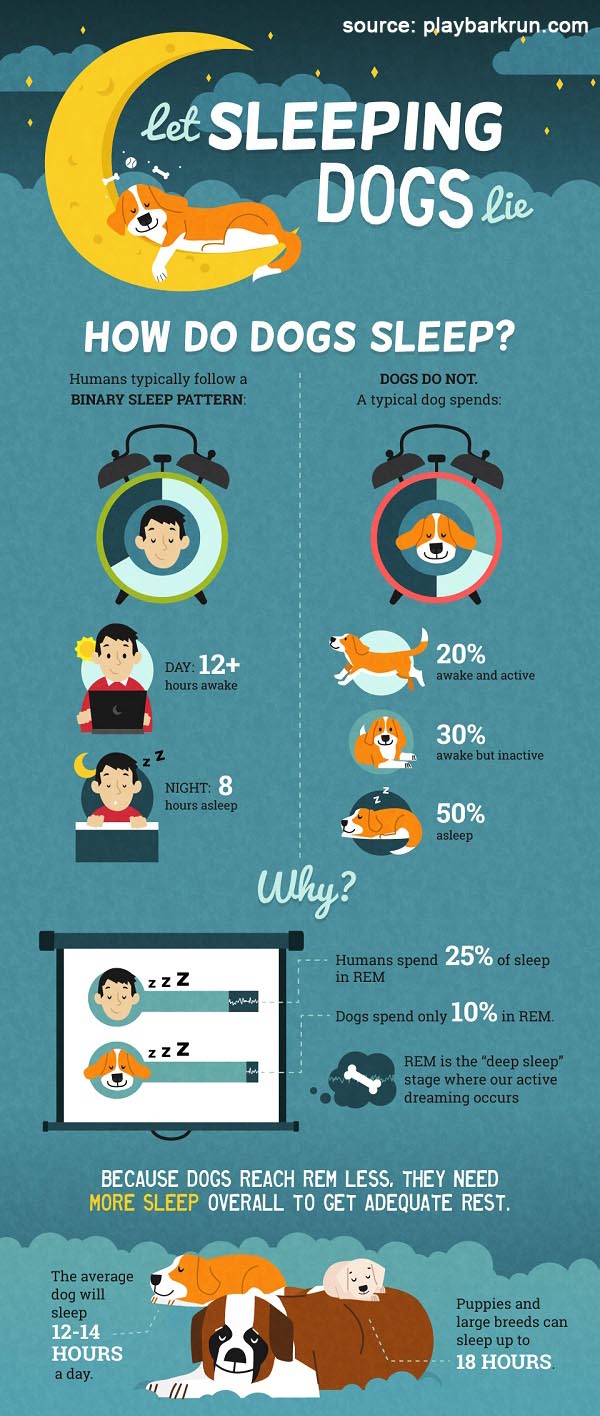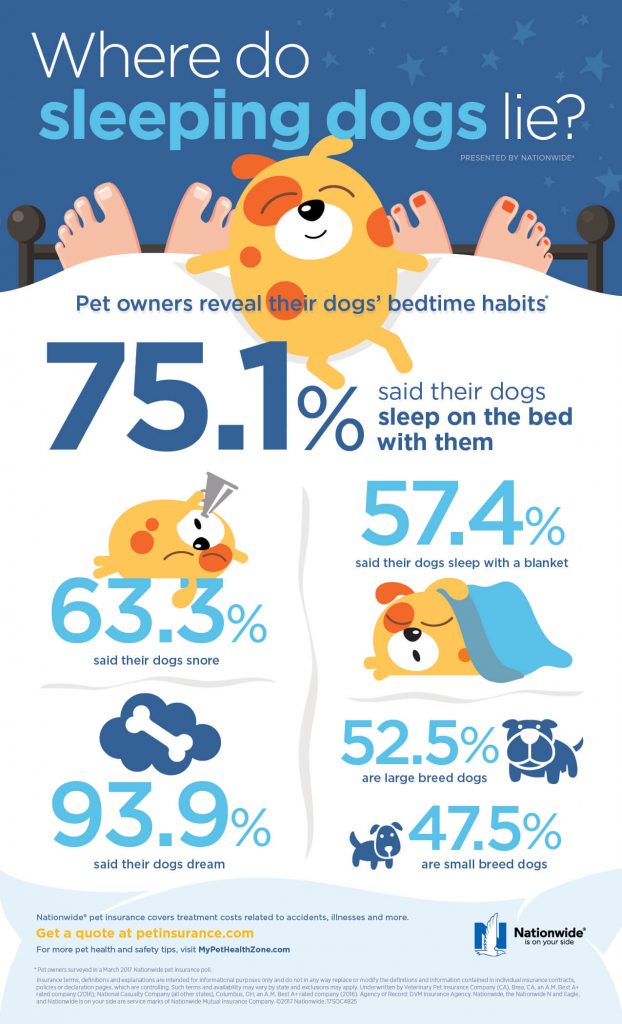A Comprehensive Guide to Co-Sleeping With Your Dog
by | Last Updated
A dog is a man’s best friend, and studies confirm it.
According to recent data, more than 60 millions of American homes share a roof with at least one dog.
And dog owners often share a bed with their pet too.
But is co-sleeping with dogs actually good for both of you? Are there any drawbacks to it and how can it affect your relationships?
If you’re looking for answers to these questions, you’ve come to the right place. By the end of this guide, you will get them all.
Quick Links
How Much Sleep Do Dogs Need?
All mammals need sleep to restore their energy, and dogs are no exception.
While we all know that newborn humans need up to 17 hours of sleep and as they grow up, their need for sleep decreases to 7-9 hours a day, it’s a bit trickier with dogs.
To precisely determine the amount of sleep your dog needs, you should consider the following factors:
- Age. Obviously, puppies need more sleep than adults, which can be as much as 18 hours a day. An adult dog, though, will need 12-14 hours. As your pet gets older, and some chronic diseases may kick in, their need for sleep increases again.
- Breed. Larger breeds, such as St Bernards, may need to snooze for 2-3 hours even after a long moderate walk, while smaller dogs tend to have a faster metabolism and hence need shorter and more frequent sleep cycles to restore their energy.
- Level of activity. Physical activity stimulates your dog’s brain, making it more alert during the day. This may sound surprising, but active dogs typically sleep less than those who have a low level of activity.
If you spend the whole day away from home and can’t help your pet be more active, you can get some games to keep him entertained when he’s alone. Puzzle toys, for example, can make him work for a treat. Another great option is chew toys, but make sure they are safe for your dog.
What’s the Difference Between Canine and Human Sleep Cycles?

Our typical sleep cycle consists of two main stages:
- NREM (Non-Rapid Eye Movement). This is a group of stages that includes light, moderate, and deep sleep. We need NREM sleep to restore the energy deposits.
- REM (Rapid Eye Movement). This is when we have dreams. Our brain uses the REM stage to process data and organize information learned during the day.
An average sleep cycle of a human lasts for about 90 minutes. Thus, we can go through 5 cycles during the standard 8-hour sleep.
Pretty strict, right?
Now, dogs. They also have two main sleep stages:
- SWS (Short-Wave Sleep). This is similar to our NREM stage. SWS occurs right after falling asleep when the dog’s body begins to relax.
- REM sleep. During this stage, dogs have more pronounced brain activity than humans do.
Depending on the breed, the dog can enter into the REM sleep stage in less than 20 minutes. You can observe it because random muscle twitching or whimpering noises typical of this stage can appear. The overall length of one sleep cycle varies between 20 and 30 minutes, again, depending on the breed.
Most Popular Sleeping Positions Among Dogs and Humans
A sleeping position matters not only in term of comfort but also in terms of health. As for humans, there are three main options:
- Side sleeping. This one is great for people who suffer from heartburn, acid reflux or snoring. No wonder it is the most common one — according to surveys, up to 70% of middle-aged adults love to sleep in a fetal position on their side.
- Back sleeping. This one is the second most common. It’s good for people with different chronic pains but bad for those with heartburn, acid reflux and snoring. Your spine remains in the most natural position this way.
- Stomach sleeping. According to most sleep experts, this one is the least healthy position, but some people do find it comfortable to lie on their belly with their arms hugging the pillow.
Now, let’s talk about our pets. Dogs have a bit wider range of sleeping positions according to their physiology:
- The Donut. Typically dogs sleep in a curled-up position. This makes them feel more secure and helps retain body heat.
- Side sleeping. As in humans, side sleeping is also pretty common in dogs. When your pet is snoozing on the side with their legs stretched out this means that they’re comfortable and safe around you.
- Stomach sleeping a.k.a. Superman. You probably saw puppies sleep this way, but adult dogs can do this too. Usually, animals choose this position to get the floor to cool them down, as the fur on their belly isn’t as thick as on the rest of the body.
- The Lion. If your dog is lying on his stomach and his head is placed on his paws, chances are he is not in a deep stage of sleep but is rather just snoozing.
Some dogs also love to cuddle with their owners or other pets in the household when they sleep. Science suggests that this may be an old habit from puppyhood, as cuddling helps puppies get warm.
How Common Is Co-Sleeping with Pets?

Now, I’ve got some numbers for you:
- According to statistics, 68% of American households have pets. Two-thirds of them are cats and dogs, and the rest includes birds, fish, rabbits, ferrets, rodents, and other less common pets.
- In 2017, there were about 90 million dogs living as pets in US households, which shows that the number of dog owners has increased by some 22 million since 2000.
- According to the American Pet Products Association, almost 50% of dog owners allow their pet to sleep with them. Obviously, smaller breeds are more likely to be allowed on the owner’s bed than medium and large dogs. The percentages are 62, 41, and 32 correspondingly.
- Now, what about the dogs that aren’t allowed on the bed? Well, the survey conducted by the American Kennel Club showed that 20% of dog owners crate their dogs for the night, 17% use a special dog bed, 4% have an outdoor shelter for their pet, and the rest just let the dog sleep somewhere indoors, meaning there’s no permanent sleeping spot.
Sleeping With Your Dog 101: Pros and Cons
So, numbers say that many of us Americans do co-sleep with our furry friends. If you’re thinking to do the same, you may be wondering:
Is it bad to sleep with your dog?
Well, as usual, there are some good and some bad things about it.
Let’s begin with the good because co-sleeping with a dog actually has plenty of benefits for you:
- Increased sense of security. According to the Mayo Clinic survey, 41% of dog owners felt more secure and comfortable when their pet slept nearby. Although the survey didn’t indicate whether people and animals shared a bed or just a bedroom, this doesn’t change the fact that having a dog by your side increases the feeling of being protected. According to scientists, the possible reason behind this might be that dogs are much more sensitive to danger and can signal you if anything suspicious happens.
- Therapy of some sleep disorders. According to the publication in the Sleep Review magazine, dogs can be very beneficial for people who suffer from sleep disorders, such as night terrors, obstructive sleep apnea, sleepwalking, and narcolepsy.
- Natural heating pad. The warmth from your dog’s body can act as a heating pad or hot bottle during cold nights. This can be extremely helpful if you have cold feet or hands.
- Pain relief. The University of Alberta found that having a dog in the bed helped patients with chronic pains to fall asleep faster and sleep longer. Cuddling with a pet before sleep also reduced the feeling of loneliness and anxiety while providing relaxation and improving overall mood.
If your dog is used to have breakfast or go for a walk on a certain time, he may help you get more organized.
All of this sounds great, doesn’t it? But what’s in it for the pet?
Well, there are some benefits too:
- Stronger emotional bonding. If you’re an office worker with a fixed schedule, then your dog may spend most of his day alone. That’s why sharing a bed can become an excellent compensation for the time spent separately and can increase the feeling of connection between you two.
- They feel happy and loved. Studies find that dogs can experience depression and separation anxiety when they’re apart from their owners. Even if the owner is in the next room. Thus, if you allow your pet to sleep with you, they may actually feel happy and calm.
Now, check out the possible downsides of sleeping with your dog:
- Lower sleep quality. Although a recent study by the Mayo Clinic showed that having a dog in your bedroom didn’t decrease the sleep quality and duration, a number of other studies found that allowing a pet under the sheets may lead to disrupted sleep. The reason behind this is that sleeping with a dog is like having a restless partner by your side. Some dogs tend to scratch and lick their owner, move a lot in their sleep, or make annoying noises. Unless you’re a heavy sleeper, this is not what you want at night.
- Allergies and asthma exacerbation. Dogs have fur and skin — the potential allergens that accumulate on your bed sheets. Even if you regularly wash your bedding, the tiny particles can penetrate into the mattress, and there’s literally no way to get them out of it. When they build up, your mattress becomes a perfect place for dust mites — another common allergen. That’s why if you have hypersensitivity or are prone to allergies, it’s better to keep your pets out of your bed.
- Parasites. This is another major concern. See, if your dog spends time outside and interacts with other pets and some things you’d prefer to avoid, he can become a source of parasites that can transfer to you, such as worms or ticks. Of course, if you wash him often and don’t allow outside, any chances of this happening are much lower. But it’s still something to keep in mind.
- Pathogens and diseases. The Center for Disease Control and Prevention reports that animals transmit as much as 60% of all human infectious diseases. When it comes to dogs, the most dangerous ones are bubonic plague, rabies, and meningitis. Although such cases are not common, the risks are higher for children, older people, and those with immune deficiency and skin injuries.
Small breeds or older dogs can have a problem with getting in and out of bed, especially if it’s high. So, you need to consider your animal safety before letting them snuggle with you.
And what about your furry friend?
The main reason why your dog shouldn’t sleep with you is that he might become spoiled.
You probably know that to maintain a healthy relationship with your pet, you need to be “the boss” for him.
Sharing a bed with your dog may make him think that now you two are equal. As a result, your dog might try to assert dominance in everyday life by misbehaving or being aggressive.
Overall, it’s up to you to decide whether the benefits outweigh the downsides and risks.
But here’s the thing:
All those health risks can be eliminated if you clean your room and visit the vet regularly. And as for the quality of sleep and possible misbehavior of your dog, you can consult a dog handler. They will tell you how to train your dog to sleep on your bed without disturbing you and can help you with dominance issues.
How to Do It Right? A Few Tips on Sleeping With Your Dog
Finally, let me give you some recommendations on how to make co-sleeping with your dog easy and comfortable for both of you:
- Bathe and brush your dog. This should be done regularly to ensure that no dirt, fur, and dangerous particles will appear on your bed. It’s also highly advised to pay special attention to your dog’s paws, as that’s where the pathogens might be hiding.
- Check his health. Vet visits are a must for every pet owner. Don’t forget to deworm your dog every three months and enforce their immune system with vaccinations.
- Train him. Give your dog a particular corner of your bed and teach him to sleep only there. Use positive reinforcement, such as treats, if your pet behaves nicely. You can also train your dog to use a separate bed, which can be placed in your room right beside your own bed. Thus, you will still be close but won’t interrupt each other’s sleep.
So, are you already sharing a bed with your dog or only considering this? Do you think this is beneficial or harmful to both of you? Share your thoughts in the comments!




Tammy Fincher
Feb 15, 2020 at 1:13 amI can’t imagine sleeping without my dog. We both feel more secure and safe.